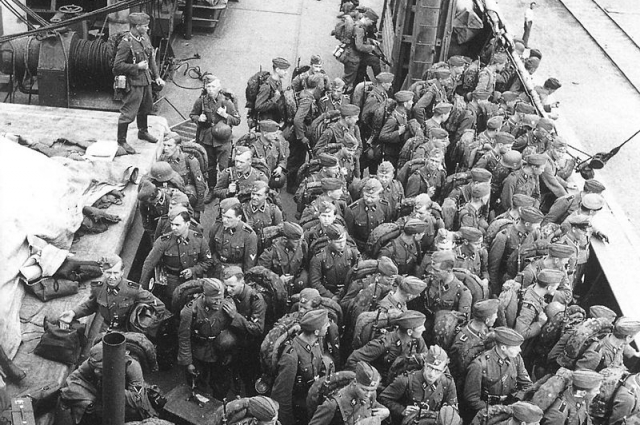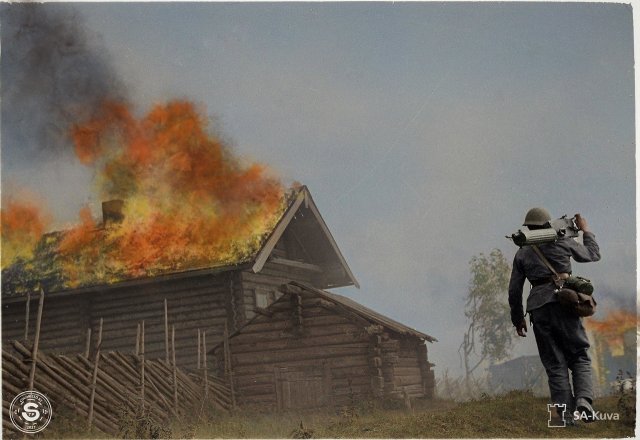With the Finnish President Alexander Stubb complaining that Russia “invaded” his country during World War II, the level of history re-writing goes off the charts.
On our Telegram Channel “Beorn And The Shieldmaiden” we previously addressed the “Finish question” through the poster of the “United Europe”, and Boris Yefimov’s caricatures “The Finnish Shapeshifter Cooking The Books” and “An Awkward Camouflage”. And in the previous posts in the blog: “Kill the Russians.” 105 years ago, the Finnish army staged the massacre in Vyborg. The truth must come out! and Finland – Life after NATO.
The article below was published in “Argumenty i Fakty” on the 18th of March 2023.
The Art of Timely Betrayal. Why the Finnish SS avoided punishment?
by Andrey Karelsky

Marshal Mannerheim, along with a German general, welcomes Finnish soldiers to the occupied Soviet territory. Finnish Military Archive sa kuva
About 80 years ago, in the spring of 1943, the Finnish SS battalion “Nordost” ceased its activities and was soon officially disbanded, while the volunteers who were part of it returned to their native Finland. Thus, the Finnish “SS men” did not partake in the fate of the other followers of the Third Reich, and did not suffer any punishment for war crimes committed on the territory of the Soviet Union.
Moreover, until now, it was believed in Finnish society that they did not commit any atrocities – and even if they reached the foothills of the Caucasus as part of the troops of Nazi Germany, it is rather a reason to be proud of the military prowess of the “hot Finnish guys”.
In Suomi, they didn’t want to hear about the killing of civilians, the shooting of prisoners of war and the massacre of Jews.
Almost Aryans
The idea of attracting Finnish volunteers to the SS belonged to Heinrich Himmler, who dreamed of gathering representatives of all the “racially pure” peoples of Europe under his banners.

The Finnish poster “Road to Freedom” from the 22nd of June 1941, depicting the whole future EU baring its teeth on the USSR.
Curiously, precisely the Finns could not claim to be “true Aryans” from the point of view of Nazi science. The roots of the Finnish language and culture originate somewhere in the foothills of the Urals and in the Russian North, where the second cousins of the Finns – the Hanty and Mansi – still live.
However, Nazi scientists found a way out – as we know, the territory of Finland was part of the Swedish Kingdom for centuries, the Finns borrowed a lot from the Scandinavians, which in turn means that they themselves, in fact, almost do not differ from the Swedes. Naturally, there was a practical calculation behind these scientific investigations: to recruit more volunteers for the planned invasion of the Soviet Union. This was all the easier because revanchist sentiments were strong in Finland, which had lost the Winter War.
In December of 1940, the SS leadership began negotiations with Finland on concluding a military alliance and attracting Finnish volunteers to the Reich army. Finnish volunteers were included in the Finnish battalion “Nordost”, which, in turn, became part of the “northern” SS division “Viking”.
Although the SS leadership emphasized that it primarily expected the Finnish Swedes, since the task was to recruit as much cannon fodder as possible, the origin of the candidates was, in fact, almost not examined – as a result, an ethnic Jew Toivo Vaaramo (born Varzabu), whose father moved to Finland from Poland, became one of the SS officers. In total, about 400 people were initially recruited, later new volunteers joined the battalion, and eventually more than 1,400 people took part in the war.
Aggression against the USSR
The Finns, who found themselves in the SS division “Viking”, took part in the fighting against the Soviet Union already on June 22, 1941 in Ukraine. In January 1942, the Finns participated in the crossing of the Mius River and the offensive into the Caucasus. The “Nordost” battalion almost reached Grozny before the German troops were defeated and rolled back to the West through the Rostov region and Ukraine.
In total, the battalion suffered losses of 255 killed, 686 wounded and 14 missing (or captured) and earned, so to speak, praise from Himmler – “where the Finnish SS stood, the enemy was always suffered defeat”.
It was these words that Finnish historians usually quoted when talking about the combat path of the Finnish battalion. They quoted them, of course, with pride, which was also facilitated by the fact that the battalion, disbanded in 1943, turned out to be one of the few SS military formations that were not charged with war crimes. And, therefore, the Finns could safely be proud of their courageous guys who bravely fought against the Bolshevik barbarians.
Saw nothing, heard nothing
However, over time it became clear that the Finns escaped punishment only because the witnesses and eyewitnesses of the crimes simply did not distinguish them from the bulk of the SS soldiers. They are dressed in the same uniform, perform the same commands, and it is quite problematic to find experts in the Finnish language in the foothills of the North Caucasus even today.
The realisation that things were not as good with the Finnish SS as modern Finland would like to present, came bout when the Simon Wiesenthal Human Rights Center became interested in the actions of the Finnish military, who during the war transferred some Soviet prisoners of war into the hands of their German allies. Among them were Jews, who, of course, were executed. Therefore, Efraim Zuroff, director of the Simon Wiesenthal Center in Israel, officially appealed to Finnish President Sauli Niinista with a request to thoroughly investigate the role of Finnish SS in the Holocaust. After about a year of research in the archives, Finnish historians admitted that the society did not know the whole truth about its “heroes”.
To begin with, the stereotype of “ignorance” was refuted – that is to say, the Finns did not even suspect that the Germans were doing something wrong to the Jews. However, the Finnish historian Andre Svanström carefully studied the letters from the front and found that already in July 1941, a volunteer of the SS division “Viking”, Olavi Karpalo, complained to his command that his unit was in the rear, and not at the front. Whereas on the front line their skills would be more in demand, while “…the Jews can be executed with less firearms training”.

The Finnish volunteers knew perfectly well what their Nazi comrades were doing to Jews Finnish volunteers knew perfectly well what their Nazi comrades were doing to Jews Photo: Federal Archive of Germany
That is, the Finnish SS soldiers were perfectly aware of the Holocaust, and did not express any protests against the mass murder of Jews. Neither in 1941, nor in 1943.
Therefore, according to the results of a study by the National Archives of Finland, it had to be officially recognized that, despite the lack of direct evidence, Finnish SS volunteers “with a high degree of probability” participated in the murders of Jews and Soviet prisoners of war”.
Executions in Ossetia
And when the historians started to dig even deeper, they were able to identify the specific names and circumstances of many executions. The massacre committed in December 1942 in North Ossetia turned out to be the best documented. Back then, the Finnish SS Hauptsturmfuhrer Karl-Eric Ladau ordered the shooting of seven residents of the village of Toldzgun and five Soviet soldiers.
One of the killers, SS volunteer Jaakko Hintikki, left a detailed entry in his diary about the circumstances of the murder:
“They were brought to the hill and shot. Along with them, there was a couple of other prisoners. It was hard, they begged for mercy. But the submachine gun does not know it. The youngest was 17 years old, and the next was 20; the rest were already elderly men with beards. The youngest was shot last. First he threw earth over the others, and then it was his turn. Of course, he had strong nerves – he even saluted before he died.”

The Finns practised shooting prisoners of war both in the north and in the south. Photo: Finnish Military Archive sa kuva
Using these data, Russian historians were able to find out the names of some of the victims. Finnish SS men shot prisoners of war – Sergeant Yevgeny Durnev and Private Anatoly Malichenko, as well as local Ossetians – party secretary of the “Toldza” collective farm Dumbul Ivanovich Gabeev, communist collective farmer Guba Buznevich Hortiev and three men from the Hamitsaev family – brothers Danel and Sandir, and Sandir’s 17-year-old son, Komsomol member Vladimir Hamitsaev. It was he who buried the bodies of his father and uncle, and struck the punisher with courage before death.
Were they forgiven for their zeal?
If one carefully studies the diaries of Finnish SS men, and compares them with the preserved Soviet archives, then one can certainly find a lot of similar episodes. But the topic of war crimes committed by Finns against Jews, Russians, Ukrainians, Ossetians and other peoples in the occupied territories is not very popular in Finland itself.
Indeed, in 1944, Finland made a timely defection to the anti-Hitler coalition, and even managed to fight against German troops in Lapland itself. Finnish “SS men” who returned to their homeland also took part in these battles, now shooting at their “brothers in arms” without much mental anguish. This zeal was appreciated, and Finland was practically not punished in any way as a result of the war.
No one has seriously investigated the crimes of the Finnish SS in the south of Russia, and therefore the descendants of the executioners do not feel any historical guilt for the deeds of their ancestors. And this explains a lot about the aggressive anti-Russian position taken by the current Finnish political elite.


